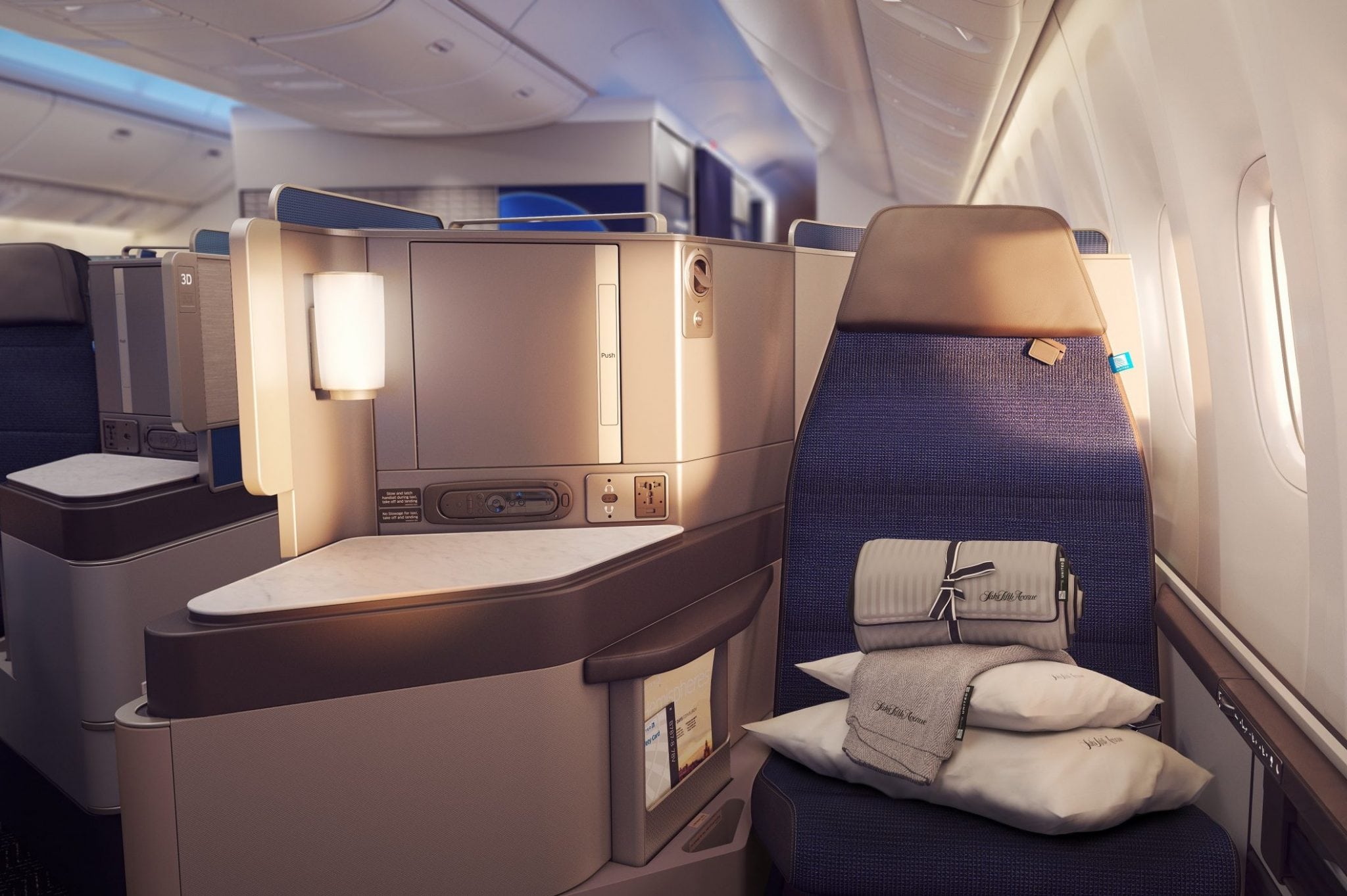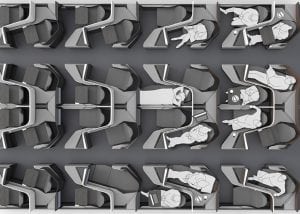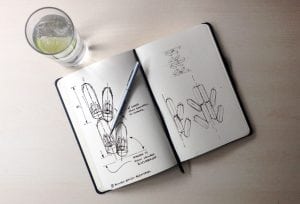Skift Take
Design firm Acumen did something no one thought possible. It created a high-density, direct-aisle access business class cabin for United Airlines. Will passengers like it? We'll find out early next year.
In creating the new United Airlines business class layout, designers at Acumen, a London-based consultancy that also delivered Etihad’s Residence suite, did something few thought possible.
For United’s new Polaris cabin, Acumen’s designers figured out how to replace United’s two current business class configurations, which require many passengers to step over seat-mates to reach the aisle – with one that allows easy aisle access for all, and they did so without requiring the airline to remove any seats. According to Acumen, after retrofits, United’s Boeing 777s and Boeing 787s will have exactly as many premium seats as today – in the same space.
“They had been told by other manufacturers that this wasn’t doable,” said Ali Ersan, one of the designers.
This was a big deal. New-generation seats almost always take up more space than what they replace. Airlines have been willing to take the revenue hit because they’re engaged in something resembling an arms race. Each is trying to come up with a more luxurious business class cabin than the next, as carriers seek to sway the same deep-pocketed passengers.
A business class retrofit similar to United’s typically costs an airline at least four seats, Acumen’s designers say. That can add up to a lot revenue. On some days this summer and fall, United is selling nonstop business class fares between San Francisco and Singapore for $10,000 or more, roundtrip.
Take four seats away, and it could be the difference between a profitable and unprofitable flight.
Some airlines have been willing to fly with fewer seats, hoping passengers might pay more for a more spacious pod. But under former CFO John Rainey and former CEO Jeff Smisek, United had been relentlessly focused on maintaining costs, raising revenues and increasing efficiencies — to the detriment of nearly everyone including their best passengers. In 2013, United launched what it called Project Quality, a multi-year effort to cut $2 billion in annual costs. At the same time, United was trying to increase revenues.
With this Acumen-designed configuration, United is betting it found the right tradeoff between density and seat quality. It claims more than 12,000 hours of research went into designing the Polaris seat and experience, with the airline even holding fake overnight flights at Boeing’s Seattle headquarters, complete with flight attendants serving meals and simulated aircraft noise. London-based PriestmanGoode created the look and feel of the seats and cabins, developing in-suite features such as coat and bag storage, a pull-out table with a tablet holder and charging stations, and choosing new tableware, glassware and amenity kits. But Acumen is directly responsible for the unusual, space-saving configuration.
United expects to introduce the Polaris seat early next year on its new Boeing 777-300s. It will then spend several years retrofitting some existing Boeing 777s and Boeing 767s with the new seat, as it also adds it to new Boeing 787-10s and Airbus A350s.
“We were basically the only one that could offer a full-flat bed, loads of spaces and all-aisle access without losing any seats over the existing configuration,” Acumen designer Daniel Clucas said.
A COMPLETELY NEW DESIGN
For Acumen, United’s June 2 event to unveil the seat was the culmination of years of planning and experimentation. According to company lore, Acumen CEO Ian Dryburgh scribbled the layout on paper years ago while drinking a gin and tonic on a London commuter train.
Believing it found the perfect combination of seat density and comfort, Acumen then patented it, and started shopping it to airlines.
“It’s almost like the perfect business class layout has been a riddle and a puzzle that has been playing in our minds over the past 10 years,” said Anthony Harcup, another of the designers.
What Acumen did is reimagine the cabin’s design. Though British Airways introduced the first flatbed business class seat in 2000, most of the world’s other airlines did not copy until five to 10 years ago. And only in the past three to five years did airlines decide customers needed not only flatbed seats, but also unimpeded aisle access. United had been among the first airlines to introduce flatbeds in 2008, but its two main current products lack aisle access. One is particularly dense, with two seats near the window, four in the middle and two seats on the other window.
But as other airlines rushed to give passengers what they wanted, some carriers installed seats that, while comfortable, may waste too much space without giving passengers a markedly better product. For United’s cabin, the designers said they sought to eliminate “dead space.”
Much of space-savings comes from how Acumen oriented the seats. In most cabins, all seats are either oriented on an angle, or they are aligned straight. But Acumen’s design is different. Some seats are angled, while others face forward. This has never been done before, and Acumen’s designers aren’t sure why.
“Every inch has been carefully crafted and painfully optimized,” Ersan said.
Rethinking the cabin was challenging, as designers had to be careful not to copy other seats, even accidentally. Several companies compete for the same business, and each owns patents for designs – some for things as minor as how an armrest sits near a footwell.
“With any new seat idea it’s necessary to duck and tiptoe around a number of existing tripwires that is the landscape of [intellectual property,]” Harcup said.
One of the trickiest parts was developing a design that could work on many aircraft, including the Boeing 777, Boeing 767, Boeing 787 and Airbus A350. All of the cabins are different width, and other designers have struggled with how to allow airlines to use the same seat on every aircraft. This is part of the reason Delta Air Lines and American Airlines use a completely different seat design on their narrower 767s than on other aircraft.
But Acumen figured it out. Most of United’s wide-bodies will have one seat on each window, with two in the middle. But the 767s will have what is essentially a 1-1-1 configuration.
“With every aircraft, we had to slightly tweak some dimensions, like seat width or the dimensions of the seat,” Clucas said.
Corners cut?
The designers say customers will not notice that United’s configuration is more dense than what many other airlines offer. This is important, because savvy travelers paying thousands of dollars on airfare tend to prefer roomier cabins.
United’s seat will be as long as 6-feet-6 inches and as wide as 23 inches, though it could be tighter on some aircraft due to space limitations. That’s on par with some of the world’s better products, including from airlines like Emirates. In its biggest form, United even says the Polaris seat is roughly the same size as its current global first class seat, which the airline will phase out over the next several years.
“It’s fine to talk about how efficient it is,” Ersan said. “But the most important thing about this layout is the efficiency of it without compromising the passenger space. Anyone can create a a really efficient layout but if a passenger can’t be comfortable in it, no airline is going to buy it.”
Analysts and passengers will watch closely to see if United can pull off implementation. The airline produced a highly-choreographed New York event in June to show off the seat, and while many in attendance said they liked it, there’s a difference between a seat in a ballroom and one on an aircraft.
The Future of Flatbeds
In North America, United has a five-year exclusivity window on this seat, so Acumen is not shopping it elsewhere. But the designers said it is possible another airline elsewhere might try a similar configuration.
But even if no one copies it, Acumen’s designers predict more airlines will seek more efficient designs. Or, if they do chose to install fewer seats, they may want to make those seats much more luxurious than those replace.
“The release of Polaris will make people see that if you can offer all of this and be incredibly space efficient, the next generation of products is going to have to be even better,” Clucas said.
As for whether designers can create something even more efficient than bothers, Acumen’s designers say they’re watching carefully.
“In terms of being able to maximize space we are interested to see if anyone comes up with anything more efficient than Polaris, definitely,” Harcup said.
The Daily Newsletter
Our daily coverage of the global travel industry. Written by editors and analysts from across Skift’s brands.
Have a confidential tip for Skift? Get in touch
Tags: business class, passenger experience, united airlines
Photo credit: London-based design firm Acumen created a new business class configuration for United Airlines. United Airlines


